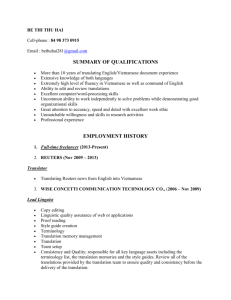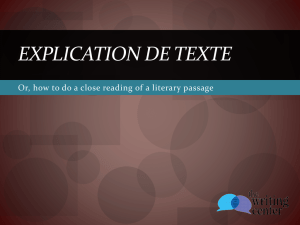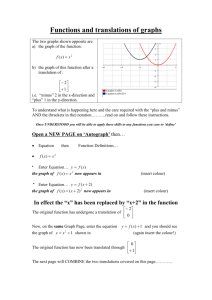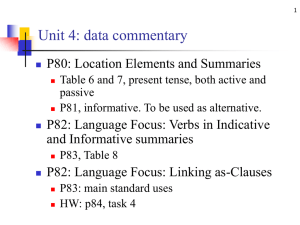Modern language
advertisement
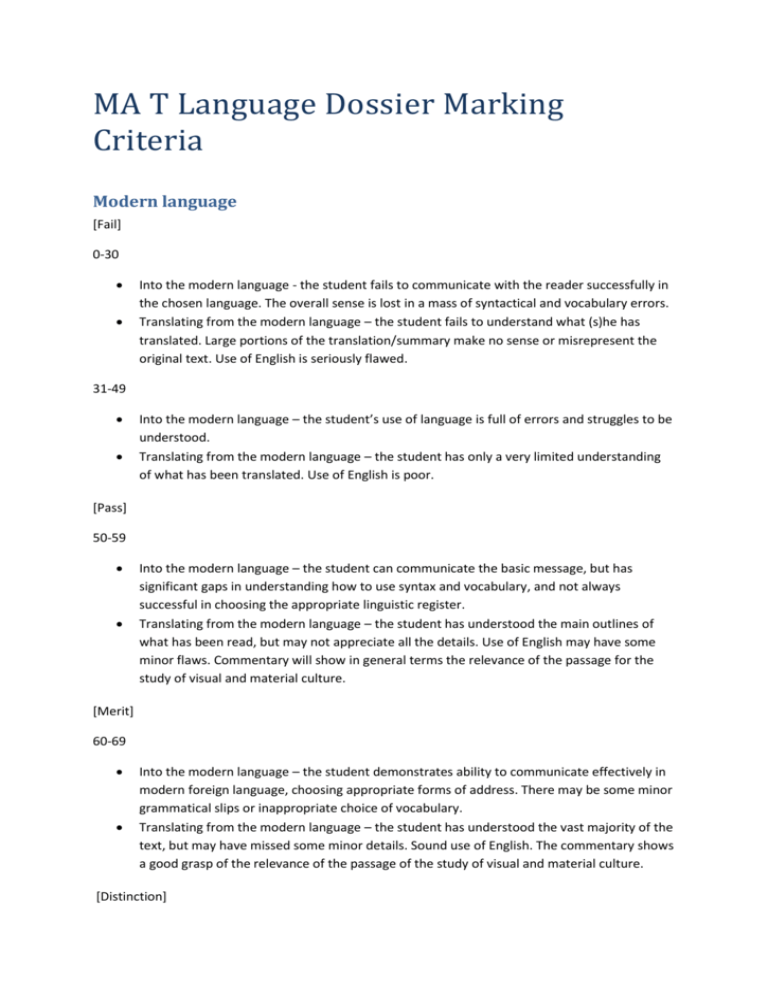
MA T Language Dossier Marking Criteria Modern language [Fail] 0-30 Into the modern language - the student fails to communicate with the reader successfully in the chosen language. The overall sense is lost in a mass of syntactical and vocabulary errors. Translating from the modern language – the student fails to understand what (s)he has translated. Large portions of the translation/summary make no sense or misrepresent the original text. Use of English is seriously flawed. 31-49 Into the modern language – the student’s use of language is full of errors and struggles to be understood. Translating from the modern language – the student has only a very limited understanding of what has been translated. Use of English is poor. [Pass] 50-59 Into the modern language – the student can communicate the basic message, but has significant gaps in understanding how to use syntax and vocabulary, and not always successful in choosing the appropriate linguistic register. Translating from the modern language – the student has understood the main outlines of what has been read, but may not appreciate all the details. Use of English may have some minor flaws. Commentary will show in general terms the relevance of the passage for the study of visual and material culture. [Merit] 60-69 Into the modern language – the student demonstrates ability to communicate effectively in modern foreign language, choosing appropriate forms of address. There may be some minor grammatical slips or inappropriate choice of vocabulary. Translating from the modern language – the student has understood the vast majority of the text, but may have missed some minor details. Sound use of English. The commentary shows a good grasp of the relevance of the passage of the study of visual and material culture. [Distinction] 70-79 Into the modern language – the student demonstrates ability to communicate effectively in modern foreign language, in accurate and clearly expressed language. Shows an awareness of formal protocols of the medium and addressee. Makes a clear and persuasive case for the request being made. Translating from the modern language – has grasped both details and essentials of the text being translated. Excellent English. The commentary will reveal the ability to critique the passage’s relevance to ancient visual and material culture, and will show an awareness of its scholarly context. 80-100 Into the modern language- student presents a fluent, idiomatic text. Translating from the modern language – student offers a flawless account. Excellent English. The commentary will make sophisticated and original observations about the passage’s relevance to ancient visual and material culture, and will locate fully in its scholarly context. Ancient language [Fail] 0-30 Translation shows serious weaknesses. No evidence that student has understood the original language in the text. Commentary contains little content of value; poorly structured and unpersuasive arguments and reasoning. Comments are demonstrably inaccurate. Makes no relevant comment on text’s significance to visual and material culture. Poorly written and rambling. Misunderstands linguistic features and/ or historical context. Lacks necessary scholarly apparatus (footnotes/ bibliography). 31-49 Translation shows serious weaknesses in linguistic understanding. Commentary is limited to general comments. Structure of arguments and their cogency show signs of confusion or are short of detailed and clear reasoning. General comments on visual and material culture, but unrelated to the text. Engages superficially with a small range of secondary scholarship. Scholarly apparatus weak. Use of English lacks clarity and accuracy. [Pass] 50-59 Translation is too derivative from a published version, not demonstrating the student’s own understanding of how the syntax is working. Is aware of a range of scholarship, but analysis mainly summarises the reading rather than advancing own views. Little use of comparanda to illustrate the source’s relevance for the study of visual and material culture. [Merit] 60-69 Translation is sound, but with some minor errors in syntax or vocabulary. Detailed knowledge of historical and literary context. Some use of comparanda. Some awareness of interpretative problems; makes sensible and well-referenced comments on the source's relevance for the study of visual and material culture. Some good comment on linguistic details of passage. Written clearly and accurately. [Distinction] 70-79 Accurate translation by student. Commentary demonstrates critical engagement with existing translations. Offers alternative translations/ interpretations, with supporting materials and comparanda. Analysis offers interesting and original observations on literary style and context and upon historical context. Illuminates issues of visual and material culture. Clear, insightful, methodologically aware, and convincing. Detailed knowledge of historical and literary context. Perceptive use of comparanda. Good and detailed analysis of language used in the passage. Written clearly and accurately. Engages critically with a broad range of secondary bibliography. 80-100 Accurate translation of publishable quality by student showing good sense of linguistic nuances in the text. Commentary demonstrates critical engagement with existing translations. Offers alternative translations/ interpretations, with supporting materials and comparanda. Analysis offers interesting and original observations on literary style and context and upon historical context; insightful, methodologically aware, and convincing. Pertinent and original insights on the relation between linguistic detail and contextual and thematic analysis. High level of insight into source’s significance to visual and material culture. Perceptive and extensive use of comparanda to discuss distinctiveness of this text. Acute appreciation of interpretative problems in dealing with this source. Written in flawless, clear English. Engages critically with a broad range of secondary bibliography.
